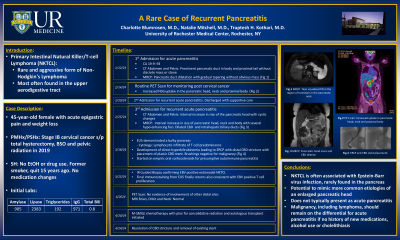Tuesday Poster Session
Category: Biliary/Pancreas
P3593 - Rare Case of Recurrent Pancreatitis
Tuesday, October 29, 2024
10:30 AM - 4:00 PM ET
Location: Exhibit Hall E

Has Audio
- CB
Charlotte Blumrosen, MD
University of Rochester Medical Center
Rochester, NY
Presenting Author(s)
Charlotte Blumrosen, MD, Natalie Mitchell, MD, Truptesh Kothari, MD
University of Rochester Medical Center, Rochester, NY
Introduction: Natural killer/T cell lymphoma (NKTCL) is an aggressive form of non-Hodgkin’s lymphoma occurring secondary to Epstein Barr virus (EBV) infection. The incidence of intestinal NKTCL is low, and symptoms present atypically, including, in rare instances, with acute pancreatitis.
Case Description/Methods: A 45-year female with cervical cancer status-post hysterectomy and pelvic radiation presented with abdominal pain, laboratory and imaging findings consistent with acute pancreatitis. There was no history of new medications, alcohol use or cholelithiasis. Abdominal CT revealed a prominent pancreatic duct. MRCP was notable for pancreatic duct dilation with gradual tapering concerning for obstruction without obvious mass. Outpatient follow-up was recommended.
In the interim, PET scan for cervical cancer surveillance revealed increased FDG uptake in the pancreatic head. Shortly thereafter, she was admitted for recurrent acute pancreatitis. Abdominal CT showed increased size of the pancreatic head. CA 19-9 level was 93. EUS with FNA revealed an abnormally enlarged pancreatic head but cytology was unremarkable. Given non-diagnostic cytology results, she underwent a repeat EUS with FNB, which revealed a bulky pancreas. Initial cytology revealed lymphocytic infiltrate of T-cell predominance, suggestive of chronic inflammation. Her hospital course was complicated by a direct hyperbilirubinemia. MRCP demonstrated a dilated common bile duct (CBD). ERCP was notable for a distal CBD stricture, for which a plastic stent was placed. Brushings were negative for malignancy. She was empirically started on oral corticosteroids due to concern for autoimmune pancreatitis.
Immunostaining from EUS cytology returned consistent with EBV-positive T cell proliferation, concerning for lymphoma. IR guided biopsy revealed EBV positive extra-nodal NKTCL. She was started on M-SMILE chemotherapy with plans for consolidative radiation and potential autologous transplant. Interval ERCP showed resolution of the CBD stricture with subsequent removal of the stent.
Discussion: NKTCL is most often found in the upper aerodigestive tract (nasal type) but is rarely seen in the pancreas. It remains a challenging diagnosis due to its atypical features and potential to mimic more common etiologies of an enlarged pancreatic head or rarely acute pancreatitis. Malignancy should always remain on the differential, particularly if there is no history of new medications, alcohol use or cholelithiasis.
Disclosures:
Charlotte Blumrosen, MD, Natalie Mitchell, MD, Truptesh Kothari, MD. P3593 - Rare Case of Recurrent Pancreatitis, ACG 2024 Annual Scientific Meeting Abstracts. Philadelphia, PA: American College of Gastroenterology.
University of Rochester Medical Center, Rochester, NY
Introduction: Natural killer/T cell lymphoma (NKTCL) is an aggressive form of non-Hodgkin’s lymphoma occurring secondary to Epstein Barr virus (EBV) infection. The incidence of intestinal NKTCL is low, and symptoms present atypically, including, in rare instances, with acute pancreatitis.
Case Description/Methods: A 45-year female with cervical cancer status-post hysterectomy and pelvic radiation presented with abdominal pain, laboratory and imaging findings consistent with acute pancreatitis. There was no history of new medications, alcohol use or cholelithiasis. Abdominal CT revealed a prominent pancreatic duct. MRCP was notable for pancreatic duct dilation with gradual tapering concerning for obstruction without obvious mass. Outpatient follow-up was recommended.
In the interim, PET scan for cervical cancer surveillance revealed increased FDG uptake in the pancreatic head. Shortly thereafter, she was admitted for recurrent acute pancreatitis. Abdominal CT showed increased size of the pancreatic head. CA 19-9 level was 93. EUS with FNA revealed an abnormally enlarged pancreatic head but cytology was unremarkable. Given non-diagnostic cytology results, she underwent a repeat EUS with FNB, which revealed a bulky pancreas. Initial cytology revealed lymphocytic infiltrate of T-cell predominance, suggestive of chronic inflammation. Her hospital course was complicated by a direct hyperbilirubinemia. MRCP demonstrated a dilated common bile duct (CBD). ERCP was notable for a distal CBD stricture, for which a plastic stent was placed. Brushings were negative for malignancy. She was empirically started on oral corticosteroids due to concern for autoimmune pancreatitis.
Immunostaining from EUS cytology returned consistent with EBV-positive T cell proliferation, concerning for lymphoma. IR guided biopsy revealed EBV positive extra-nodal NKTCL. She was started on M-SMILE chemotherapy with plans for consolidative radiation and potential autologous transplant. Interval ERCP showed resolution of the CBD stricture with subsequent removal of the stent.
Discussion: NKTCL is most often found in the upper aerodigestive tract (nasal type) but is rarely seen in the pancreas. It remains a challenging diagnosis due to its atypical features and potential to mimic more common etiologies of an enlarged pancreatic head or rarely acute pancreatitis. Malignancy should always remain on the differential, particularly if there is no history of new medications, alcohol use or cholelithiasis.
Disclosures:
Charlotte Blumrosen indicated no relevant financial relationships.
Natalie Mitchell indicated no relevant financial relationships.
Truptesh Kothari indicated no relevant financial relationships.
Charlotte Blumrosen, MD, Natalie Mitchell, MD, Truptesh Kothari, MD. P3593 - Rare Case of Recurrent Pancreatitis, ACG 2024 Annual Scientific Meeting Abstracts. Philadelphia, PA: American College of Gastroenterology.

